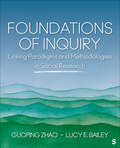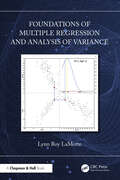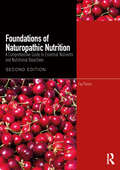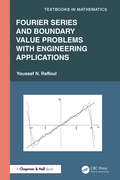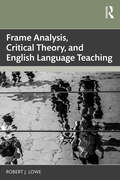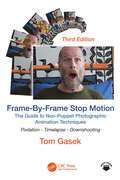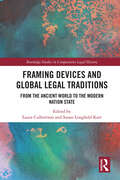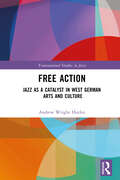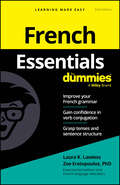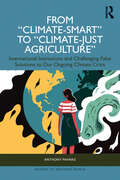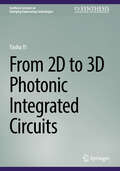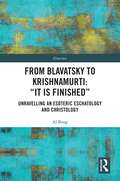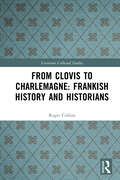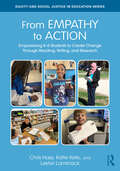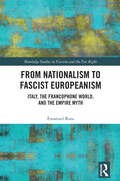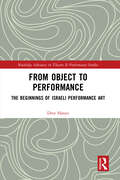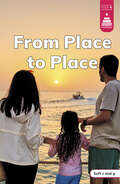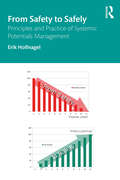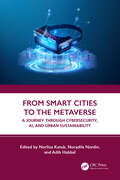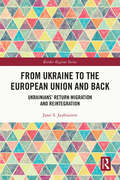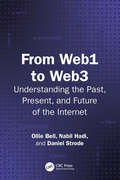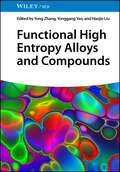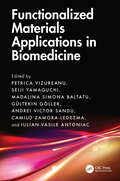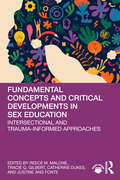- Table View
- List View
Foundations of Inquiry: Linking Paradigms and Methodologies in Social Research
by Guoping Zhao Lucy E. BaileyWhen researchers adopt a methodology, they bring to their research the theoretical assumptions infused within that methodology, and the paradigm that shapes that methodology describes their view of social life. This book is about paradigms and how they connect to methodologies. The authors explore a rich body of paradigms and how they support different methodologies and connect to designing and carrying out research. The book includes clear explanations of complex material, a thorough development of established paradigms and discussion of contemporary ones such as general interpretivism, critical race theory, and Indigenous orientations. The book′s pedagogy includes examples of published research, discussion of the issues related to each paradigm and the connections between them, and review questions and prompts to help deepen understanding.
Foundations of Inquiry: Linking Paradigms and Methodologies in Social Research
by Guoping Zhao Lucy E. BaileyWhen researchers adopt a methodology, they bring to their research the theoretical assumptions infused within that methodology, and the paradigm that shapes that methodology describes their view of social life. This book is about paradigms and how they connect to methodologies. The authors explore a rich body of paradigms and how they support different methodologies and connect to designing and carrying out research. The book includes clear explanations of complex material, a thorough development of established paradigms and discussion of contemporary ones such as general interpretivism, critical race theory, and Indigenous orientations. The book′s pedagogy includes examples of published research, discussion of the issues related to each paradigm and the connections between them, and review questions and prompts to help deepen understanding.
Foundations of Multiple Regression and Analysis of Variance
by Lynn Roy LaMotteThis book provides a rigorous development of the foundations of linear models for multiple regression and Analysis of Variance (ANOVA), based on orthogonal projections and relations among linear subspaces. It is appropriate for the linear models course required in most statistics Ph.D. programs.The presentation is particularly accessible because it is self-contained, general, and taken in logical steps that are linked directly to practicable computations. The broad objective is to provide a path of mastery so that the reader could, if stranded on a desert isle with nothing but pencil, paper, and a computer to perform matrix sums and products, replicate general linear models procedures in extant statistical computing packages.The primary prerequisite is mathematical maturity, which includes logical thinking and the ability to tell when a proof is a proof. Casual acquaintance with matrices would be helpful but not required. Background in basic statis- tical theory and methods is assumed, mainly for familiarity with terminology and the purposes of statistics in applications.The material is developed as a series of propositions, each dependent only on those preceding it. The reader is strongly encouraged to prove each one independently. Mastery requires active involvement.As part of the broad coverage of the mathematics supporting multiple regression and ANOVA, those propositions also establish several new, key results. There is a unique, best numerator sum of squares for testing an estimable function The extra residual sum of squares due to imposing a linear hypothesis tests exclusively the estimable part Models that include exclusively any given set of ANOVA effects can be formulated with contrast coding Tests of any ANOVA effects in any design and model, including unbalanced and empty cells, can be had with extra residual sum of squares due to deleting predictor variables Essential properties of Type III methods are identified and proven
Foundations of Naturopathic Nutrition: A Comprehensive Guide to Essential Nutrients and Nutritional Bioactives
by Fay PaxtonThe new edition of Foundations of Naturopathic Nutrition provides an essential but detailed guide to the principles of clinical nutrition from a naturopathic perspective.Fully updated with the latest research evidence, the text begins with an overview of basic physiological principles and the body's protective systems, such as the antioxidant, detoxification and immune systems. It then moves to an in-depth examination of different food components, including essential nutrients such as protein, lipids, carbohydrates, vitamins, minerals and trace elements, as well as nutritional bioactives, such as alpha-lipoic acid, phytochemicals, digestive enzymes and probiotics. There is detailed information on how each food component is digested and metabolised in the body and guidance on its impact on health. Including summary boxes, case studies and quizzes to help readers consolidate their knowledge, this second edition now includes an ‘evidence box’ which highlights the most recent and clinically relevant research findings on the main nutrients.There is also a new section on finding and evaluating research, from using search engines to assessing different types of research studies. This accessible and informative text will appeal to all students interested in nutrition from a complementary health perspective.
Fourier Series and Boundary Value Problems with Engineering Applications (Textbooks in Mathematics)
by Youssef RaffoulThis book is a comprehensive and time-tested guide to the mathematical theory of Fourier series and boundary value problems, with a strong emphasis on engineering applications. Over the past two decades, Fourier Series and Boundary Value Problems with Engineering Applications has been rigorously refined and tested in classroom settings, ensuring its effectiveness as a teaching and learning resource.The journey begins with a thorough development of Fourier series, a cornerstone of modern mathematics and engineering. The Fourier series provides a powerful framework for analyzing periodic functions and decomposing complex signals into simpler sinusoidal components. This foundational knowledge is then extended to boundary value problems, which arise naturally in the study of physical phenomena such as heat flow, vibrations, and wave propagation.A distinctive feature of this book is its focus on applications in both rectangular and spherical coordinates. These coordinate systems are essential for modeling problems in diverse engineering contexts. Additionally, the book addresses partial differential equations on unbounded domains and ordinary differential equations.Whether you are a student encountering Fourier series and boundary value problems for the first time, an educator seeking a reliable and classroom-tested resource, or a professional looking to refresh your knowledge, this book offers a clear exposition, practical focus, and extensive problem sets, making it an indispensable companion for mastering the mathematical tools that underpin modern engineering.
Frame Analysis, Critical Theory, and English Language Teaching
by Robert J. LoweIn this book, Robert J. Lowe introduces frame analysis, a qualitative research approach grounded in the critical theory of the early Frankfurt School and framing in the social sciences. Lowe sets out the principles of the frame analysis approach and provides a guide to conducting this kind of research in practice.Focused on identifying and challenging ideology through immanent critique, Lowe presents a methodological guide and research report. He begins by explaining early critical theory and the frame analysis approach, followed by a detailed example of its application. This example illustrates the key stages: identifying participants' ideological presuppositions through their “master framing,” questioning the internal logic of this framing, and presenting contradictions to participants. Finally, the researcher observes reactions and documents emerging counter-framing, marking the first signs of resistance to dominant ideology.By applying this approach to issues in English language teaching, the book questions some of the ways in which the rhetoric of pluralism and diversity around English as an international language may stand at odds with the realities of a world in which some varieties of the language have more prestige than others. Through the frame analysis approach, the author suggests that researchers can play a role in empowering language learners and users to advocate for a world in which they can take true ownership of the language. Key reading for all qualitative researchers and advanced students in applied linguistics, sociolinguistics, ELT/TESOL and linguistic anthropology.
Frame-By-Frame Stop Motion: The Guide to Non-Puppet Photographic Animation Techniques
by Tom GasekThis third edition of Frame‑by‑Frame Stop Motion is an up‑to‑date review of non‑puppet stop motion techniques. The reader will not only learn how to execute these techniques through descriptive chapters but also experience them with the carefully designed exercises included at the end of this book. There are many other aspects of filmmaking including design, sound, cinematography, lighting, and animation principles that make this a thorough study in non‑puppet stop motion. The animation of people, objects (not designed to be animated), light painting, time‑lapse, and downshooting are popular approaches to animation practice around the globe. This edition includes insights from the author, an experienced stop motion puppet and non‑puppet animator, as well as filmmakers from Japan to Eastern Europe to Argentina and North America. There are many aspects to this edition that should appeal not only to animators but also to photographers, live‑action filmmakers and those interested in expanding their repertoire in the filmmaking arena. Included are examples of filmmaking critiques and a wide variety of applications of photographic animation. Frame‑by‑Frame Stop Motion is the only resource of its kind.
Framing Devices and Global Legal Traditions: From the Ancient World to the Modern Nation State (Routledge Studies in Comparative Legal History)
by Laura Culbertson Susan Longfield KarrThis collection explores prefaces, prologues, paratexts, and other types of framing devices. Across world history, these devices have introduced the law, articulated its context and audience, identified the basis of legal and moral authority, critiqued existing conditions, or even tried to "restore" something that never was. Scribes, lawmakers, and legal theorists also used frames to position the law in time and space, purporting to define populations and their identities. Despite the ubiquity and complexity of these phenomena, few studies have drawn out methods for studying their role in constructing, fortifying, or reimagining legal frameworks within legal cultures or traditions. This volume offers new ways to consider the significance of framing apparatuses regarding how and why they are created, remembered, forgotten, utilized, and recovered within legal traditions. The studies range from the ancient world to the modern nation-state system, aiming to explore the intersections and collisions between juridical and political interpretation practices.The book will be of interest to academics and researchers in the areas of legal history, comparative law, legal cultures and traditions, legal theory, jurisprudence, constitutional law and legislative drafting.
Free Action: Jazz as a Catalyst in West German Arts and Culture (Transnational Studies in Jazz)
by Andrew Wright HurleyAdvancing the New Jazz Studies by focusing on questions of intermediality and cultural catalysis, this book demonstrates the role jazz played in the re-making of West German culture in the post-war era.The shadow of National Socialism, a history of German polarisation by jazz, and the influences of occupation and division, meant that jazz catalysed influential young creative artists. These included writers such as Nobel Laureate Günter Grass, Young German Cinema filmmakers like Hansjürgen Pohland, and abstract visual artists like KRH Sonderborg. Jazz provided an impulse to take into extra-musical artforms, and an impetus to reflect on what art and culture were. Through considering poetry, the novel, photography, film and television, graphic design and the fine arts, this volume reveals how German creatives were influenced not only by American jazz culture, but also by cultural innovations from elsewhere, and by German traditions they considered less compromised by the Nazi era. The book also explores the limits of this catalysis, examining for example how African-Americans received the German representation of jazz culture.Written in an accessible style, this important contribution to New Jazz Studies and German Studies scholarship will appeal to both graduate and undergraduate students or researchers in the fields of jazz history, twentieth-century musicology, and European or German cultural studies.
French Essentials For Dummies
by Laura K. Lawless Zoe ErotopoulosGet right to the good stuff with this easy-to-follow guide to French fundamentals French Essentials For Dummies, 2nd Edition walks you through the core concepts of French so you can apply right away and start communicating effectively. From conjugating verbs to understanding tenses, this easy-to-read guide skips past the fluff and dives deep into the basics you need to improve your French and succeed on a French class exam and more. This guide helps you figure out the right articles, adjectives, and pronouns you need to use in different situations. Plus, you'll also get expert advice on when to use the past tense, the imperfect, and how to express the future. Inside: Make adjectives agree, understand the different parts of French speech, and select the right preposition Correctly ask and answer yes or no questions and participate in simple conversations Use important verb distinctions, correctly pronounce French words, and deploy proper grammar Perfect for everyone taking a French class, undertaking solo French study, or anyone looking for a handy, practical supplement to improve their understanding of the language, French Essentials For Dummies, 2nd Edition is a hands-on reference packed with the tools, tips, and strategies you need to speak French.
From "Climate-Smart" to "Climate-Just Agriculture”: International Institutions and Challenging False Solutions to our Ongoing Climate Crisis (Bridges to Another World)
by Anthony PahnkeCombining innovative social theory with ongoing policy discussions on climate change, this book analyzes past and present efforts at challenging global poverty through reforming the dynamics of worldwide agricultural production.Focusing on the efforts of the World Bank and CGIAR research centers, particularly through research and projects that have been launched by the International Maize and Wheat Improvement Center (CIMMYT) and the International Food Policy Research Institute (IFPRI), “Climate-Smart” to “Climate-Just” exposes how neoliberal principles of limited government and individual entrepreneurship have expanded through the development of “Climate-Smart Agriculture.” At the same, an alternative – “Climate-Just Agriculture” – is becoming possible as rightwing populists have disrupted international free trade orthodoxy, and social movement demands for food sovereignty gain traction in key international spaces.As Pahnke explains in this innovative account, “Climate-Just Agriculture” includes structural changes to free trade agreements that would build from local and regional food systems to make them resilient in the face of the adverse effects of climate change. This resiliency, moreover, allows marginalized groups the capacity to create and participate in markets that allow for greater self-sufficiency to push back on colonialism and imperialism.Written in a clear and accessible style, this book will be essential reading for students and scholars of sociology, environmental studies, and politics, as well as for policymakers and professionals involved in climate change policy and the agriculture and food industry.
From 2D to 3D Photonic Integrated Circuits (Synthesis Lectures on Emerging Engineering Technologies)
by Yasha YiThe integration of photonics and electronics has transformed the landscape of modern technology. At the forefront of this revolution is the development of Photonic Integrated Circuits (PICs). Historically rooted in the traditional 2-D fabrication processes inherited from electronic Integrated Circuits, PICs shifted to 3-D configurations, introducing new design philosophies that impact scalability, efficiency, and performance. This convergence of electronic and photonic circuits presents unique challenges and great opportunities. This book provides an introduction to photonic integrated circuits and the transition from 2D to 3D PICs. It then describes design and fabrication techniques of 3D PICs and related challenges and solutions. Finally, applications of 3D photonics, emerging technologies and industry outlook are also discussed.
From Blavatsky to Krishnamurti: Unravelling an Esoteric Eschatology and Christology (Gnostica)
by Al BoagThis book highlights some important continuities as well as differences between the teachings of Helena Petrovna Blavatsky (1831–1891), co‑founder of the Theosophical Society in 1875, and Krishnamurti Jiddu (1895–1986), the Theosophist who was trained to be the World Teacher. Until now very little has been written of the importance to Blavatsky of an esoteric eschatology and Christology, and their relation to the secret core of her Path of Initiation: the practice of an occult breathless meditation. Similarly, scholarly research has overlooked the evidence that Krishnamurti eviscerated the secret core of Blavatsky’s teaching with his own esoteric interpretation of it, which exists in his published work as the camouflaged core of his teaching.Offering a fresh appraisal, this work draws on careful exploration of the primary source material of Blavatsky and Krishnamurti as well as his Theosophical mentors Annie Besant (1847–1933) and Charles Webster Leadbeater (1854–1934). It will be of particular interest to students and scholars of esotericism, new religious movements and the history of religions.
From Clovis to Charlemagne: Frankish History and Historians (Variorum Collected Studies)
by Roger CollinsThis book is a collection of papers on Frankish historiography in the Merovingian and early Carolingian periods, from the late sixth to early ninth centuries, and studies numerous individual texts, evaluating their witness to the events they describe. It also includes hitherto unpublished items on the so-called Chronicle of Fredegar, in both its original and eighth-century versions, and also an entirely new article on the Merovingian dynastic crisis of 613, along with a general introduction and a bibliography of its author’s writing.Particular attention is focused on the element of deception, deliberate or otherwise, in the narrative accounts of some of the Frankish histories and chronicles and on the way they were written in order to promote specific interpretations of certain individuals and events, or in some cases to conceal their very existence. Certain central episodes such as the imperial coronation of Charlemagne are examined to detect the ways in which they were interpreted and presented in contemporary texts.From Clovis to Charlemagne: Frankish History and Historians will appeal to academics and students interested in the history of early medieval France, the processes of historical composition in that period, the study of manuscripts relating to it and the wider questions about historical understanding and the interpretation of evidence.
From Empathy to Action: Empowering K–6 Students to Create Change Through Reading, Writing, and Research (Equity and Social Justice in Education Series)
by Lester Laminack Katie Kelly Chris HassHow can we move children from simply talking about things to learning to take action – and feeling empowered to enact change? This book shows you exactly what this can look like in an elementary class setting. It details the structures and instructional strategies classroom teachers can adopt to help their children create positive outcomes for their communities while also building identities for themselves as real agents of change.Topics include building empathy and compassion, helping students become aware of issues within their communities, creating brave environments so students can engage in productive discussions around sensitive topics, engaging students in research that answers their needs and those of their community, and supporting students into action. Classroom examples, practical tools, and student voices are featured throughout.With this book by your side, you can debunk the false deficit-based assumptions that young people aren’t ready for activism, and you’ll see what is possible when we commit ourselves to integrating civic learning into our classroom literacy instruction.
From Nationalism to Fascist Europeanism: Italy, the Francophone World, and the Empire Myth (Routledge Studies in Fascism and the Far Right)
by Emanuel RotaThis book traces the intellectual history of fascist Europeanism, examining how Italian and Francophone fascist thinkers envisioned European unity as a means of consolidating power, overcoming nationalist divisions, and resisting external threats rather than promoting peace or democracy.Readers will discover how fascist thinkers—from Mussolini and Drieu La Rochelle to Evola, Thiriart, and Romualdi—reimagined European unity as a radical alternative to liberal democracy, driven by visions of power, hierarchy, and racial identity. By exploring pivotal debates on nationalism, modernity, and empire, this book reveals the hidden ideological struggles within fascist Europeanism and their enduring legacy in today’s far-right movements. Richly grounded in historical analysis and original sources, it provides a provocative new perspective on European integration as an ongoing political battleground.This book is intended for scholars, researchers, and students of modern European history, fascism, and political ideologies. It will also be of interest to those studying contemporary far-right movements and the historical roots of European integration.
From Object to Performance: The Beginnings of Israeli Performance Art (Routledge Advances in Theatre & Performance Studies)
by Dror HarariFrom Object to Performance identifies, analyses, and critically contemplates the advent of a “performance mentality” and the gradual maturation of a “performative turn” in Israeli art.Manifested in the transition from object-oriented art to performance-based art, this cultural moment reflected both the exposure and responsiveness of young Israeli artists to experimental currents in North American and Western European art and these artists’ need to respond to acute social and political conditions, questioning Israeli national myths and collectivist ideals. From Object to Performance offers the first comprehensive exploration of the origins of action and performance art in Israel, contributes an important component to unravelling the global enigma of performance art histories, and considers the historiographic challenges encountered when studying the emergence and early years of performance-based practices. This book will appeal to students and scholars of performance studies, art history, cultural studies, and Israel studies, as well as to curators of contemporary art and performance, and artists. The book should also be of interest to the growing number of theater and art historians who research the beginnings and development of action and performance art.
From Place to Place
by Laura StickneyPeople travel from place to place in cars, boats, or planes. Some people move to find new homes or jobs. Beginning readers hone their phonics skills while learning how and why people travel to new places. As readers practice decoding words with soft c and soft g, they gain nonfiction knowledge. Every Stairway Decodables nonfiction book combines multiple aspects of the Science of Reading to support small group instruction, independent reading, and reading practice at home.
From Safety to Safely: Principles and Practice of Systemic Potentials Management
by Erik HollnagelThe conventional interpretation of safety, known as Safety-I, denotes a condition where as little as possible goes wrong, and the focus of practical efforts in management or analysis is on the occurrence of unacceptable outcomes and on how to reduce their number to an acceptable level, ideally zero. The emphasis is therefore on how to manage safety as such, as seen in the ubiquitous safety management systems (SMS). As Professor James Reason astutely points out, this raises the interesting question of how it is possible to learn about something, let alone manage it, if it is studied only in situations in which it is absent. The solution proposed by and described in this book is to stop using safety as a noun and instead use it as an adverb: safely.Now often referred to as Safety-II, this solution is the logical consequence of resilience engineering and will require new methods, several of which already exist and have proved their worth in practice for years. The question ceases being what to manage and becomes how to manage. Managing safety is protective, hence a non-productive cost, which at best avoids a loss. Conversely, managing safely is productive and can generate revenue in addition to preventing or avoiding losses; aviation and mining are prime examples.From Safety to Safely provides a practical perspective on managing safely, illustrating a practical form of synesis. It offers a new understanding of safety, combining concerns for productivity and safety rather than juxtaposing them, and it shows how to manage complex industrial and social systems in the spirit of resilience engineering and synesis. It is the first book to completely dispense with the loaded term "safety" while offering a practical and viable alternative. Spoiler alert: this book does not mention or analyse any celebrated accidents.This book is for all middle and senior managers, board members, and independent consultants seeking to ensure safe, revenue-generating operations.
From Smart Cities to the Metaverse: A Journey through Cybersecurity, AI, and Urban Sustainability
by Norliza Katuk Noradila Nordin Adib HabbalThis book offers a comprehensive exploration of the convergence between smart city infrastructure and the emerging metaverse. This book highlights the importance of integrating advanced technologies such as artificial intelligence, virtual reality/augmented reality, and blockchain to enhance urban living experiences while addressing such innovations’ security and ethical challenges. Its applications span urban planning, transportation, education, historic preservation, and inclusive city development, making it an essential resource for modern urban development.The book covers many key areas critical to understanding and implementing smart cities and the metaverse. It starts with both domains’ foundational concepts and technological underpinnings, followed by a deep dive into the security infrastructure and challenges smart cities face. Cybersecurity is given special attention, exploring motives and methods of cyberattacks and proposing mitigation techniques and best practices. The book also examines AI chatbots, intelligent transportation, and the integration of digital twins, providing practical case studies and insights. Furthermore, it addresses the socioeconomic implications, governance, and ethical considerations, ensuring a holistic approach to the subject.The motivation for writing this book stems from the contributors’ recognition of the transformative potential of smart cities and the metaverse in creating sustainable, efficient, and inclusive urban environments. By bridging the gap between theoretical research and practical application, the contributors aim to equip researchers, policymakers, and technologists with the knowledge and tools needed to navigate and shape the future of urban living in a digitally interconnected world.
From Ukraine to the European Union and Back: Ukrainians’ Return Migration and Reintegration (Border Regions Series)
by Jussi S. JauhiainenThis book examines the experiences of Ukrainians who fled the escalated war, focusing on their journeys to the European Union, adaptation there, and eventual return and reintegration into Ukraine.Drawing on fieldwork in Ukraine in 2024 and 2025, surveys, and interviews with returnees, it provides detailed analysis and vivid accounts of displacement and return. It also incorporates findings from organizations such as UNHCR and IOM, and explores potential post-war developments shaping both returnees’ lives and Ukraine’s future.Aimed at scholars, policymakers, and all interested readers, the book sheds light on Ukrainians’ migration experiences, their perceptions of temporary protection in the European Union, and the opportunities and challenges they face after returning.
From Web1 to Web3: Understanding the Past, Present, and Future of the Internet
by Daniel Strode Ollie Bell Nabil HadiFrom Web1 to Web3 is your definitive roadmap through the current digital revolution. Authored by Ollie Bell, Nabil Hadi, and Daniel Strode, this book offers a clear, thoughtful exploration of the internet’s evolution – from its humble, static beginnings to the dynamic, decentralized future that is emerging today.The journey begins with Web1, an era defined by a read- only landscape of information where the internet functioned primarily as a digital library. As time moved on, Web2 brought a seismic shift with its explosion of usergenerated content and the rise of social media, fundamentally changing how we communicate and share. However, as centralized platforms increasingly controlled our digital interactions and data, a new need arose – a need for a system that returned control to the individual.Enter Web3. In this new paradigm, blockchain technology, cryptocurrencies, decentralized finance (DeFi), non- fungible tokens (NFTs), and decentralized autonomous organizations (DAOs) converge to empower individuals with true digital ownership and control. Rather than relying on centralized institutions, Web3 leverages transparent, peer- to- peer networks to reimagine how we interact with the digital world.This book provides not only a historical perspective but also practical insights for businesses and individuals alike. Through case studies featuring leading global brands and actionable guides on navigating decentralized applications (dApps), readers gain an understanding of how businesses and individuals are already using Web3 technologies to drive innovation and create value. Whether you’re an entrepreneur, investor, developer, or a digital native keen to reclaim your data and identity, this book offers the knowledge you need to adapt and thrive in this rapidly evolving landscape.Beyond the technical details, From Web1 to Web3 explores the broader cultural and economic shifts brought about by decentralization. It examines how these changes are redefining what it means to be connected and how trust is built in a world where power is shifting from centralized authorities to individual users.This book is a balanced and accessible guide, providing the context, analysis, and practical advice required to understand the present and future of the internet. Your journey into the evolving world of Web3 begins here.
Functional High Entropy Alloys and Compounds
by Yong Zhang Yonggang Yao Haojie LiuAn up-to-date guide to understanding, designing, and using high entropy materials In Functional High Entropy Alloys and Compounds, a team of distinguished researchers delivers a comprehensive exploration of high entropy materials for functional applications. It’s an interdisciplinary discussion highlighting the role of high entropy materials in various industries and examines the real-world applications of high entropy alloys and compounds. The authors illustrate the potential of these materials to transform different industries and cover both bulk HEA materials and HEA nanoparticles. Functional High Entropy Alloys and Compounds offers a structured and in-depth exploration of high entropy materials. It examines critical fundamentals, including their characteristics, structures, phase transformations, and microstructures, as well as corrosion, anti-oxidation, and additive manufacturing and phase control. Readers will also find: A thorough introduction to the functional properties of high entropy materials Comprehensive explorations of the real-world applications of high entropy materials, including 3D printing, thermoelectrics, optoelectronics, thermal catalysts, electro-catalysts, and energy storage Practical discussions of nanoscale high entropy materials and high entropy materials for thermal-catalytic applications Complete treatments of clean energy and electrocatalysis and high entropy materials for energy storage Perfect for materials scientists, metallurgists, electrochemists, and catalytic chemists, Functional High Entropy Alloys and Compounds will also benefit aerospace engineers and physicians and thermodynamics physicists.
Functionalized Materials Applications in Biomedicine
by Petrica Vizureanu Andrei Victor Sandu Seiji Yamaguchi Madalina Simona Baltatu Gültekin Göller Camilo Zamora-Ledezma Iulian-Vasile AntoniacThis book offers an in-depth exploration of biomaterials with a primary focus on recent developments. It begins by providing a comprehensive background on the basic principles of biomaterials, followed by the synthesis, properties, and performance of various biomaterials. Subsequent chapters discuss topics such as biocompatibility, the interaction of biomaterials with the human body, and the role of biomaterials in regenerative medicine. It also addresses the technological advancements in biomaterials, novel fabrication methods, and surface modification techniques backed by case studies.Features: Presents the latest advancements in biomaterials, including novel fabrication methods, innovative materials, and groundbreaking applications in medical devices and regenerative medicine Offers a holistic view of the biomaterials field, bridging various disciplines such as biology, chemistry, materials science, and medicine Illustrates practical applications of biomaterials in tissue engineering, drug delivery systems, and medical imaging Delves into the ethical, regulatory, and commercial dimensions of biomaterials Includes detailed case studies on topics such as thermal properties, corrosion resistance, and industrial coatings This book is aimed at researchers and graduate students of bioengineering, biomaterials, and materials science.
Fundamental Concepts and Critical Developments in Sex Education: Intersectional and Trauma-Informed Approaches
by Tracie Q. Gilbert Reece M. Malone Catherine Dukes Justine Ang FonteThis comprehensive resource equips emerging and experienced sexuality educators with contemporary frameworks for trauma-informed, equitable, and anti-oppressive education.It provides foundational principles for development and delivery, emphasizing inclusivity, accessibility, and intersectionality. Editors Malone, Gilbert, Dukes, and Fonte curate chapters by leading voices on topics such as historical perspectives, values, emotional intelligence, professional humility, reproductive justice, neurodivergence, sex work, kink, childhood and adolescent sexualities, faith-based education, social media, and entrepreneurship. Authors demonstrate decolonization, trauma-informed care, and equity in practice.With practical applications and reflective questions, this book is a vital guide for creating and teaching impactful, inclusive sex education for diverse audiences.
